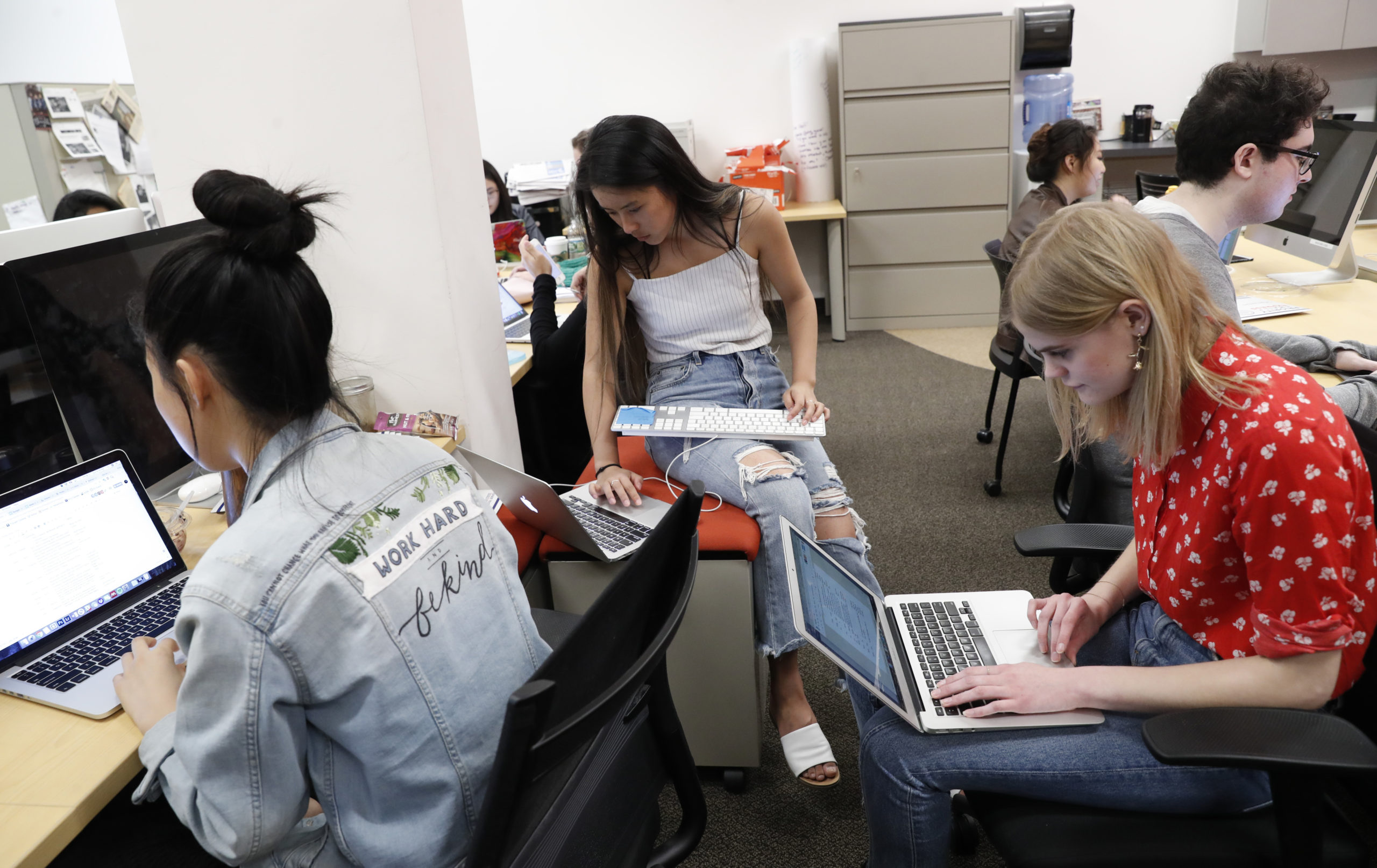
At Tarrant Community College, José Romero discovered a love for journalism working for the student paper. But as a 21-year-old Hispanic journalist who grew up working-class in Texas without a degree from a well-known university, Romero is unsure about what the path might look like for him to get there
José Romero always thought he was something of an introvert until he discovered a love for journalism and interviewing people at Tarrant County College, a two-year community college in Fort Worth, Texas. Romero joined the school paper, The Collegian, where after a few semesters, he was elected editor-in-chief. Next year he’ll transfer to the University of Texas at Arlington, and he wants to pursue journalism as a career. His dream job: to become a video game journalist at a publication like Bloomberg.
But as a 21-year-old Hispanic journalist who grew up working-class in Texas without a degree from a well-known university, Romero is unsure about what the path might look like for him to get there.
“My status is going to be something people look at and say that I’m not distinguished enough and that I didn’t get the proper education needed to be a journalist,” Romero says, noting that he hopes the training and mentorship he’s getting at school will help overcome some of the barriers. “It’s an unfortunate reality, and I hope that I’m exaggerating, but it’s stuff I have to put into consideration. I’m going to have to put in that extra effort and need to find a way to get myself known because I don’t know anyone in the industry.”
The lack of adequate pipelines into journalism for candidates from different backgrounds has contributed to the fact that newsrooms too often don’t look like the communities they cover — a refrain often repeated by but rarely addressed. According to the American Society of News Editors’ diversity survey published in 2019, people of color were only 21.9 percent of the workforce of the 428 U.S. newsrooms that responded. A survey published in 2016 from researchers at the University of Missouri and University of Illinois showed that nearly 94 percent of working journalists who responded had at least a bachelor’s degree, despite the fact that a little more than one-third of adults in America do.
Much of the pipeline problem has to do with retention issues — how journalists from different backgrounds are treated when they enter institutions that were not made for them. But it’s also about how, and whether, journalists can even enter the industry in the first place
It’s not hard to understand why this might be. Many of the traditional entry paths to journalism — whether it’s coming up through the private university school paper, the state school journalism undergrad program (which can still cost multiple tens of thousands of dollars), or by attending a J-School master’s program — are inaccessible for most people. Journalism, like many other culture-worker, white collar jobs, tends to recruit from the same set of colleges and backgrounds. A 2018 survey of summer interns at seven national publications — The Wall Street Journal, The New York Times, The Washington Post, the Los Angeles Times, NPR, Politico, and the Chicago Tribune — found that 65 percent of the interns came from highly selective universities that make up only 13 percent of four-year colleges.
Aside from the full rides that some elite private schools can offer low-income students, going through most of these paths means taking on hefty student loans and starting in debt in a precarious industry. Yet those schools are often necessary for many non-white, non-rich people starting out in journalism. As journalist Rachelle Hampton wrote in Slate, “As a Black woman I didn’t have a choice not to go to J-school … Journalism is an industry rife with nepotism, where career trajectories are determined more often by the people that you know rather than the quality of your work.”
Without deep networks or safety nets, getting a coveted entry-level internship or trying to start out by freelancing can be extremely difficult; many people are locked out by default. Yet journalism desperately needs more reporters who have backgrounds like Romero’s and Hampton’s. Much of the pipeline problem has to do with retention issues — how journalists from different backgrounds are treated when they enter institutions that were not made for them. But it’s also about how, and whether, journalists can even enter the industry in the first place.
Some people within newsrooms, non-profit organizations, and educational institutions are attempting to build up and reimagine these pipelines, even as the industry continues to face financial challenges, whether through sustained mentorship programs, investing in wider outreach for paid internships and training, or expanding flexibility around what journalism work looks like. Labor unions are also working to lift workplace conditions overall by raising salaries and improving benefits, which are some of the most straightforward ways to allow people from different kinds of backgrounds to support themselves. There are a number of solutions, well-trod and inventive alike, should institutions care to invest in them.
For a time, the traditional pipeline into journalism was to get experience as an intern or entry-level assistant at a smaller local paper, maybe moving into a general assignment reporting job at a medium-size regional newsroom, then perhaps honing a beat and eventually getting hired at a larger, national newsroom. But over the past few decades local newsrooms have been under duress; a PEN America report from 2019 found that since 2004, over 1,800 newspapers — an estimated 20 percent of the national total — had closed.

Students at the Washington Square News at New York University work on deadline in the paper's newsroom. Many of the traditional entry paths to journalism, like the private school newspaper route, are inaccessible for most people
The decimation has continued in recent years. Poynter recently memorialized 90 local newsrooms, some more than 100 years old, that have closed since the pandemic began. Broadcast television has been relatively more stable job-wise, but faces similar threats of corporate consolidation. With the shuttering of these regional newsrooms comes the decline of that natural progression that used to usher many journalists through the early days of their careers.
While new entry points into journalism have appeared — new reporters can always, say, start a Substack or podcast — those options don’t necessarily ensure a secure career. “The future when I was a young journalist was much clearer than the future now,” but there are fewer paths available today, says Kim Kleman, senior vice president of Report for America, a national service program responding to the decimation of local journalism. For journalists who might be graduating with hefty student loans, Kleman says, it’s hard to imagine or plan for a sustainable future in the industry.
Report for America places emerging journalists — nearly half of whom are journalists of color — into newsrooms around the country. The program pays half of the journalist’s salary for the first year and provides training and mentorship for corps members.
Eve Zuckoff, a 25-year-old climate change and environment reporter for public radio station CAI in Woods Hole, Massachusetts, went through this pipeline — she was hired by the station after completing a Report for America program there. Before she was a corp member, Zuckoff was doing freelance production for a radio station in Boston, but her situation was less than stable, and there wasn’t a clear way forward. “The pipeline from freelance producer to paid employee is really hard to navigate and can be really disheartening,” Zuckoff says. She wanted to do more reporting and credited Report for America — which also paired her with a newsroom mentor at WCAI — for allowing her to learn the skills she needed to cover her beat. “It’s really, really hard to be a local reporter and learn how to do that job. To do it with institutional support, it really made a difference and was helpful in a holistic way,” she adds.
While new entry points into journalism have appeared — new reporters can always, say, start a Substack or podcast — those options don’t necessarily ensure a secure career
Megan Greenwell, co-director of the Princeton Summer Journalism Program, which provides journalism mentorship and training for low-income high school students, says that many of the students who have gone through their program don’t necessarily end up in journalism even if they’re interested, because of the industry’s precariousness. “There’s less and less out there,” Greenwell says of local entry level newsroom opportunities, noting that her students at Syracuse University, where she taught sports journalism, now mostly apply for production assistant or editorial assistant jobs at big national publications. “The best part of local newspaper internships was that they were so small that someone would go on vacation, and I would get to take their beat, which was amazing, and try all these different things.” At their best, those internships were in places where the cost of living might be much lower compared to say, magazine internships in big cities, allowing for a broader swath of people to get a foothold in an industry.
Over the past decade, there has been a movement to eliminate unpaid internships, a practice that severely restricts who can get a foot in the door in any industry. However, one 2018 survey by the National Association of Colleges and Employers found that 43 percent of all internships at for-profit companies are still unpaid. When it comes to journalism itself, even paid internships often pay too little, without considering covering expenses like housing or transportation. Many interns interviewed by The Objective, a non-profit newsroom reporting on the industry’s systemic biases, pointed out how it was an issue that, say, some publications expected their interns to have access to a car to do the necessary reporting, instead of providing one for them.
Yet these internships — as hard as they are for many to get into — are often a prerequisite to get a full-time job in the industry, or even simply to get another, “bigger” internship. Take Hampton’s experience — she said she worked three internships during college, most of which she credited getting mainly because of the connections she had by attending Northwestern. She then secured her first fellowship out of college at The New Republic in New York City, where she made $30,000 per year, a difficult salary to live on. (Full disclosure: I am also a past TNR fellow.)
Hampton says she had no idea how she was even going to afford the move, until she won $4,000 from an essay contest at her school. “I remember getting that email in one of my final classes, and I started crying,” Hampton says. “Up until that point, I had zero clue how I was going to afford [it].” Considering up-front costs for interns, investing in meaningful mentorship and training, and hiring students from non-elite colleges are some clear ways newsrooms can make their programs more accessible.

“I grew up trying to look for people who look like me in the industry, and it was always the same looking kind of guys,” Romero said. “Now I’m fed up.”
And then there’s the bigger question, as Doris Truong, director of training and diversity at the Poynter Institute, wrote in Nieman Lab, of whether the internship pipeline should be so one-directional in the first place. Truong cites Poynter adjunct Kathy Lu, who notes that the system is “set up to eventually benefit the larger, dominant newsrooms (a colonist move), who get to pay intern wages to hard-working reporters who have already had several summers of experience.” Instead, Lu suggests inverting the talent pipeline, so that the bigger papers with the most resources train and supply talent for local news outlets that so desperately need coverage.
“It’s all misbilled to us that local journalism is a stepping stone; it actually doesn’t have to be at all,” says Zuckoff, the CAI reporter. She points to the depth of local expertise needed to cover her community and says she values the impact she can have as a local journalist.
It’s clear that as news deserts grow, local, in-house opportunities are diminishing. Carrie Graham got into journalism because she was seeing so much misinformation on Facebook and wanted to do something about it. The 33-year-old enrolled in Santa Ana College, which is a community college, in 2019 to take journalism classes. She’s now the editor-in-chief for the school’s paper, el Don, where she especially enjoys the service journalism they do. An article they posted on how to get your stimulus check found an audience beyond the school because the larger community is often lacking the information it needs. Graham’s goal is to keep doing this kind of hyper-local journalism, but she’s worried that with growing news deserts, those jobs will be hard to come by.
Still, the existing network of community colleges can play a big role in training journalists and expanding the pool. Sarah Bennett, who chairs communications and media studies department at Santa Ana, notes that schools like hers are already acting as a pipeline to bring more voices into the journalism industry. “A lot of newsrooms are going backwards and asking, ‘How do we reconnect with the community?’” she says, pointing out that colleges like hers are already uniquely positioned to figure out how to get journalism skills to more people. “We are the community. These are programs that already exist on a community basis.”
“There are so many different kinds of perspectives lacking in newsrooms because we have had such a rigid idea overall of what qualifies somebody to become a good journalist” —Rhema Bland, director of the Ida B. Wells Society for Investigative Reporting
Bennett, who was once a student in the same program she now chairs, is herself a product of this very pipeline. She eventually transferred from Santa Ana to the University of Southern California, where she came to the student newspaper with experience in multiple sections from her work in a smaller student newsroom. Bennett started writing professionally by freelancing at alt-weeklies and eventually became an editor at LA Weekly. There, she found it difficult to keep expanding the pipeline and mentor younger writers since the publication relied more on experienced freelancers with ready-to-go copy, so Bennett turned to teaching when the opportunity arose.
What’s clear is that many programs that might be overlooked by hiring managers are already training the exact people the industry needs. “There are so many different kinds of perspectives lacking in newsrooms because we have had such a rigid idea overall of what qualifies somebody to become a good journalist,” says Rhema Bland, director of the Ida B. Wells Society for Investigative Reporting, a national organization that works to train reporters of color.
One program the Ida B. Wells Society runs partners with major news organizations’ investigative units and works with them to recruit interns from historically Black colleges and universities (HBCUs) and colleges that are often overlooked. Bland says their organization also provides training and mentorship for these interns, which helps create a community they can turn to. “It’s isolating to be the Black or brown person in the room when there aren’t a whole lot,” Bland says. “We understand the importance of that support.”
Greg Morton, a 25-year-old student who graduated from Howard University in 2021 with an economics degree, was an Ida B. Wells Society data intern at ProPublica this past summer. He says applying for journalism internships was daunting, given that it wasn’t his major and he only had a couple of bylines; many required more experience or clips. The ProPublica internship application, though, felt approachable. “I think ProPublica and Ida went out of their way to have big tent applications to try to bring in as many people as possible and do that with the genuine intention of growing people as journalists,” Morton says. Going into the actual internship, he was nervous given that he didn’t come from the “traditional” journalism path, but with the mentorship and community provided by the program he was able to feel more grounded and comfortable.
For many, the entry point is cut off before they even attempt to enter a newsroom. As Joshua Benton wrote in a piece for Nieman Lab, educational institutions have a big role to play in developing these pipelines.

“Understanding how journalism operates and understanding different kinds of reporting, this idea of knowing the terrain, it’s a big thing,” says Theodore Kim, director of newsroom career programs at the Times
On the training end, Benton suggests an “alternative certification” program with some institutional prestige — similar to what K-12 teachers can get — that is affordable and accessible. Benton argues for a course that would cost a few thousand dollars and could be done remotely, with flexible hours, so that a much wider swath of people could attend. It would not only offer journalism training but also networking opportunities and would be attached to some institution with a big name in the industry, whether a journalism school, newsroom, or major foundation. As Benton puts it, “Maybe it’s time for the profession to build a new path into the industry — not just try to tweak the old ones.”
It also falls on employers to be more expansive and flexible in what they look for when hiring journalists into entry level positions. Not only do newsrooms need to look beyond certain colleges, they also have to think more broadly of ways to make their companies more accessible.
Take the move to remote work during the pandemic; allowing people to work from anywhere removes one big barrier to entry for those who might want to apply to jobs in expensive cities (although this would mainly apply to national publications). “This has to be up to organizations to be flexible in what work looks like and what showing up on the job location-wise looks like,” says Tina Sturdevant, director of talent, diversity, and inclusion at The Athletic; otherwise companies have to subsidize those moving costs. When NPR made its fall internships remote during the pandemic, the organization received 20,520 applicants for 27 openings, versus 2,597 applicants for 55 openings the year before. (I spoke with Sturdevant before The New York Times announced in January an agreement to purchase The Athletic.)
Sturdevant, who went to San Diego State University, understands the challenges of creating these pipelines. “You actively have to work at this and actively have to keep hiring managers accountable,” Sturdevant says. “A really interesting thought that’s harder to implement in practice is having the conversation of organizations putting their [diversity, equity, and inclusion] metrics and goals against their company [key performance indicators]. Are they saying, ‘If you’re not hiring diversely and not having a safe work environment, then your bonus is impacted because you did not hit the goal?’”
Not only do newsrooms need to look beyond certain colleges, they also have to think more broadly of ways to make their companies more accessible
Not all of it has to come at a large cost; The New York Times recently launched a corps program that will pair mostly freshman and sophomore college students with Times journalists, who will meet with those students a few times a year as career mentors until they graduate. “Understanding how journalism operates and understanding different kinds of reporting, this idea of knowing the terrain, it’s a big thing,” says Theodore Kim, director of newsroom career programs at the Times, noting that many schools don’t have robust career guidance infrastructure for journalism. Their plan with the program is to reach out and bring in students from schools that might not have contacts at their newsrooms.
“I think publications need to consider this part of their responsibility. We actually have a social responsibility to help hire young people and give them a path,” the Princeton Summer Journalism Program’s Greenwell says. Sustained mentorship and career guidance over time is a helpful tool; programs like that at Princeton not only provide high schoolers with summer training, but also help advise them with college applications and often into their first internships and jobs. There are also programs that have helped early career journalists, especially during the pandemic, such as the Latinas in Journalism Mentorship Program, which aims to create long-term relationships between mentors and mentees. And the Ida B. Wells Society launched a pilot program this past fall to partner with a journalism class in Riverside High School in Durham, North Carolina, which has a majority non-white student body, to train and introduce students early on to investigative journalism and working journalists.
Bennett at Santa Ana College also points to an open house that the Latino caucuses at the Los Angeles Times and Washington Post guilds hosted. She says a reporter from the Times reached out to her to make sure her students, and those at other community colleges, knew about the event. “There’s enough people now to form a caucus within the union and they are reaching down, asking how our experiences can help you get up to this level,” Bennett says.
Newsrooms need to consider alternative pipelines as a core part of their responsibility and develop them early on. Romero himself has many of the experiences that should be considered important early career training for any journalist. He has found one-on-one mentorship through his program advisors. The school paper he’s learned to report and edit at, The Collegian, is an award-winning publication that still puts out a weekly print edition. But his future in the industry is still uncertain. Romero is a first-generation college student and emphasized that he doesn’t have family money to fall back on if things don’t work out. Even if he got a coveted entry-level job at a national paper in a city like New York or Los Angeles, he’d unlikely be able to afford to move there.
Romero himself speaks to the importance of seeing other people like him succeeding in the industry and hopes he can eventually do the same. “I grew up trying to look for people who look like me in the industry, and it was always the same looking kind of guys,” Romero said. “Now I’m fed up.”


